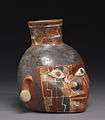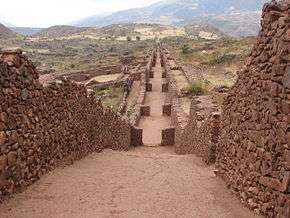Wari culture
| Huari Culture | ||||||||||||||||
| Wari | ||||||||||||||||
| ||||||||||||||||
 Middle Horizon | ||||||||||||||||
| Capital | Huari | |||||||||||||||
| Languages | Pukina, others. | |||||||||||||||
| Religion | Andean beliefs (Viracocha) | |||||||||||||||
| Government | Unknown | |||||||||||||||
| Historical era | Pre-Columbian | |||||||||||||||
| • | Established | 500 | ||||||||||||||
| • | Disestablished | 1000 | ||||||||||||||
| ||||||||||||||||
| Today part of | | |||||||||||||||
The Wari (Spanish: Huari) were a Middle Horizon civilization that flourished in the south-central Andes and coastal area of modern-day Peru, from about AD 500 to 1000.[1] (The Wari culture is not to be confused with the modern ethnic group and language known as Wari', with which it has no known link.)
Wari, as the former capital city was called, is located 11 km (6.8 mi) north-east of the modern city of Ayacucho, Peru. This city was the center of a civilization that covered much of the highlands and coast of modern Peru. The best-preserved remnants, beside the Wari Ruins, are the recently discovered Northern Wari ruins near the city of Chiclayo, and Cerro Baul in Moquegua. Also well-known are the Wari ruins of Pikillaqta ("Flea Town"), a short distance south-east of Cuzco en route to Lake Titicaca.
History
Early on, the Wari expanded their territory to include the ancient oracle center of Pachacamac, though it seems to have remained largely autonomous. Later the Wari became dominant in much of the territory of the earlier Moche and later Chimu cultures. The reason for this expansion has been debated; it is believed to have been driven by religious conversion, military conquest, or the spread of agricultural knowledge (specifically terrace agriculture).
As a result of centuries of drought, the Wari culture began to deteriorate around 800 A.D. Archeologists have determined that the city of Wari was dramatically depopulated by 1000 A.D., although it continued to be occupied by a small number of descendant groups. Buildings in Wari and in other government centers had doorways that were deliberately blocked up, as if the Wari intended to return, someday when the rains returned.[2] But by the time this happened, the Wari had faded from history. In the meantime, the dwindling residents of the Wari cities ceased all major construction. Archaeological evidence shows significant levels of inter-personal violence, suggesting that warfare and raiding increased amongst rival groups upon the collapse of the Wari state structure.[3] With the collapse of the Wari, the Late Intermediate Period is said to begin.
Government
Little is known about the details of the Wari administrative structure, as they did not appear to use a form of written record. But, the emphasis on homogeneous administrative architecture and evidence for significant social stratification suggests a complex socio-political hierarchy.
The discovery in early 2013 of an undisturbed royal tomb, El Castillo de Huarmey, offers new insight into the social and political influence of the Wari during this period. The variety and extent of the burial items accompanying the three royal women indicates a culture with significant material wealth and the power to dominate a significant part of northern costal Peru for many decades.[4]
Architecture
During its expansion period, the Wari state established architecturally distinctive administrative centers in many of its provinces. These centres are clearly different from the architecture of Tiwanaku, which is believed to have been a more federalized state by some scholars (such as John W. Janusek). Using these administrative centers, the Wari greatly influenced the surrounding countryside. They created new fields with terraced field technology and invested in construction of a major road network. Several centuries later, when the Inca began to expand their empire, they drew on both of these innovations.
Gallery
 Four-Cornered Hat, 650-1000. Brooklyn Museum
Four-Cornered Hat, 650-1000. Brooklyn Museum Huari earthenware pot with painted design, 650-800 CE (Middle Horizon)
Huari earthenware pot with painted design, 650-800 CE (Middle Horizon) Wari Tunic, Peru, 750-950 CE. This tunic is made of 120 separate small pieces of cloth, each individually tie-dyed. Ceramics of the period depict high-status men wearing this style of tunic.
Wari Tunic, Peru, 750-950 CE. This tunic is made of 120 separate small pieces of cloth, each individually tie-dyed. Ceramics of the period depict high-status men wearing this style of tunic.- Monoliths Wari
 Wari funeral bundle
Wari funeral bundle Pikillaqta administrative center, built by the Wari civilization in Cusco
Pikillaqta administrative center, built by the Wari civilization in Cusco Wig Headdress, Wari People, 600-1000 C.E, Brooklyn Museum
Wig Headdress, Wari People, 600-1000 C.E, Brooklyn Museum
See also
References
- ↑ Susan E. Bergh (2012). Wari: Lords of the Ancient Andes. Thames & Hudson. ISBN 978-0-500-51656-0. Retrieved 31 August 2013.
- ↑ Wright, Kenneth R.; McEwan, Gordon Francis; Wright, Ruth M. (2006). Tipon: Water Engineering Masterpiece of the Inca Empire. ASCE. p. 27. ISBN 9780784408513.
- ↑ Tung, TA (2008). "Violence after Imperial Collapse: A Study of Cranial Trauma among Late Intermediate Period Burials from the Former Huari Capital, Ayacucho, Peru.". Nawpa Pacha.
- ↑ "First Unlooted Royal Tomb of Its Kind Unearthed in Peru". Retrieved 2013-06-30.
Additional reading
- Collier, Simon et al. (Ed.) (1992). The Cambridge Encyclopedia of Latin America and the Caribbean (Second ed.). Cambridge University Press. ISBN 0-521-41322-2.
- Wendell C. Bennett, Excavations at Wari, Ayachucho, Peru (1953).
- Gordon F. McEwan, The Middle Horizon in the Valley of Cuzco, Peru: The Impact of the Wari Occupation of the Lucre Basin (1987).
- William H. Isbell and Gordon F. McEwan, eds., Huari Administrative Structure: Prehistoric Monumental Architecture and State Government (1991).
- Katharina J. Schreiber, Wari Imperialism in Middle Horizon Peru (1992).
- Tung, Tiffany (2012). Violence, Ritual, and the Wari Empire: A Social Bioarchaeology of Imperialism in the Ancient Andes. University Press of Florida.
External links
- Brian Finucane, "Ayacucho Archaeo-Isotope Project"
- "Archaeological chemists settle trophy-head debate
- "Pre-Incan female Wari mummy unearthed in Peru", Reuters
- "A Champion of the Wari," about curator Susan E. Bergh, by Judith H. Dobrzynski, The Wall Street Journal, October 24, 2012
- "Who Was Who in the Middle Horizon Andean Prehistory" by Patricia J. Knobloch
| Wikimedia Commons has media related to Huari. |